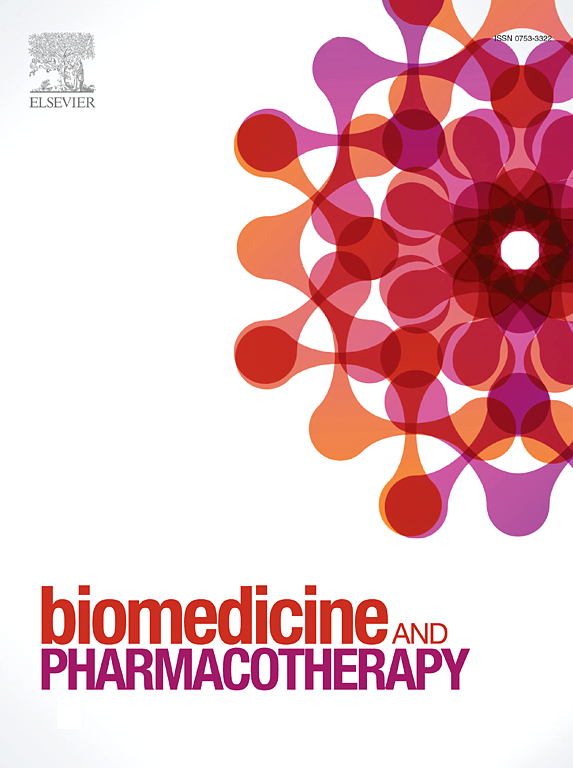Ugonin L作为一种新型的TβRs抑制剂,通过调节TGF-β/TβRs信号传导和自噬来改善肺纤维化
IF 7.5
2区 医学
Q1 MEDICINE, RESEARCH & EXPERIMENTAL
引用次数: 0
摘要
特发性肺纤维化(IPF)是一种病因不明的慢性进行性纤维化肺病,全球约有300万人受到影响。IPF的重要危险因素包括高龄和感染因子。目前fda批准的抗纤维化药物减缓了肺纤维化的进展,总体生存期有限,这突出了对新型药物的需求。Ugonin L (UL)是一种环化的香叶酮类黄酮,已被报道具有抗炎和抗氧化活性。然而,UL治疗肺纤维化的潜力仍未被发掘。在这项研究中,我们证明了UL减轻了博来霉素(BLM)诱导的小鼠肺纤维化。具体来说,UL改善了肺泡-毛细血管屏障的完整性,降低了支气管肺泡灌洗液(BALF)中的炎症因子(TGF-β1, TNF-α, IL-1β, IL-6)。UL改善了blm诱导的纤维化肺病变,减少肺损伤、肺泡间隔增厚和胶原沉积的影像学征象。在RNA-seq分析中,UL下调TGF-β1诱导的LL29人肺成纤维细胞中细胞迁移和ECM重塑相关基因。特别是,UL降低了细胞迁移、纤维化标志物表达、MMP-2活性和肌成纤维细胞活化。在分子模型中,UL与TβRI和TβRII激酶结构域的关键药效团和假定的atp结合位点相互作用。相应地,UL降低了典型(SMAD2/3)和非典型(ERK1/2和PI3K) TGF-β信号通路中关键介质的磷酸化。此外,UL下调PI3K/Akt/mTOR轴,促进TGF-β1诱导的LL29细胞自噬。综上所述,我们的研究结果表明,UL作为一种新型的TβRs抑制剂,具有治疗肺纤维化的潜力。本文章由计算机程序翻译,如有差异,请以英文原文为准。
Ugonin L ameliorates pulmonary fibrosis as a novel TβRs inhibitor by regulating the TGF-β/TβRs signaling and autophagy
Idiopathic pulmonary fibrosis (IPF) is a chronic, progressive fibrotic lung disease of unknown etiology, affecting about 3 million individuals worldwide. Significant risk factors for IPF include advanced age and infectious agents. Current FDA-approved antifibrotic drugs slow the progression of pulmonary fibrosis with limited outcomes in overall survival, highlighting the need for novel pharmacological agents. Ugonin L (UL), a cyclized geranylflavonoid derived from Helminthostachys zeylanica, has been reported to have anti-inflammatory and antioxidant activities. However, the therapeutic potential of UL for pulmonary fibrosis remains unexplored. In this study, we demonstrated that UL mitigated pulmonary fibrosis in bleomycin (BLM)-induced mice. Specifically, UL improved the alveolar-capillary barrier integrity, decreasing inflammatory cytokines (TGF-β1, TNF-α, IL-1β, IL-6) in bronchoalveolar lavage fluid (BALF). UL ameliorated lesions in BLM-induced fibrotic lungs, reducing radiological signs of lung injury, alveolar septal thickening, and collagen deposition. In RNA-seq analysis, UL downregulated genes related to cell migration and ECM remodeling in TGF-β1-induced LL29 human lung fibroblasts. In particular, UL decreased cell migration, fibrotic marker expression, MMP-2 activity, and myofibroblast activation. In molecular modeling, UL interacted with key pharmacophores and the putative ATP-binding sites of the TβRI and TβRII kinase domains. Correspondingly, UL reduced the phosphorylation of key mediators in both the canonical (SMAD2/3) and non-canonical (ERK1/2 and PI3K) TGF-β signaling pathways. Furthermore, UL downregulated the PI3K/Akt/mTOR axis and promoted autophagy in TGF-β1-induced LL29 cells. Taken together, our findings demonstrate that UL acts as a novel TβRs inhibitor and shows therapeutic potential for pulmonary fibrosis.
求助全文
通过发布文献求助,成功后即可免费获取论文全文。
去求助
来源期刊
CiteScore
11.90
自引率
2.70%
发文量
1621
审稿时长
48 days
期刊介绍:
Biomedicine & Pharmacotherapy stands as a multidisciplinary journal, presenting a spectrum of original research reports, reviews, and communications in the realms of clinical and basic medicine, as well as pharmacology. The journal spans various fields, including Cancer, Nutriceutics, Neurodegenerative, Cardiac, and Infectious Diseases.

 求助内容:
求助内容: 应助结果提醒方式:
应助结果提醒方式:


